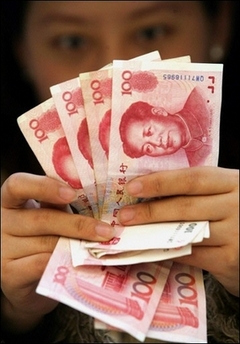Yuan hits new high against dollar
(Reuters)
Updated: 2006-09-05 15:51
SHANGHAI - The yuan set a post-revaluation high against the dollar for the
fifth straight session on Monday as the central bank largely stayed out of the
market, apparently willing to allow appreciation at a faster pace than ever
before.

This file photo shows a Chinese customer with
a handful of hundred-yuan notes at a local bank in Beijing. The yuan
posted record gains last week on speculation the Chinese currency will be
given freer rein ahead of a key economic meet of the globe's top
industrial powers. [AFP] |
But traders said they believed the People's Bank of China remained keen to
encourage two-way trade in the yuan instead of one-way speculation, so it might
engineer a temporary pullback at any time. That could make trade volatile in
coming weeks.
The yuan closed at its intra-day high of 7.9385 to the dollar, its highest
level since it was revalued by 2.1 percent and depegged from the U.S. currency
in July 2005. The previous high, set in intra-day trading on Friday, was 7.9524.
Monday's rise of 0.19 percent from Friday's close of 7.9532 was the yuan's
fourth biggest daily gain since the depegging.
The Chinese currency has now risen 0.79 percent since Aug. 15, the fastest
rise in a three-week period since the 2005 policy change. That has brought its
total gains since the start of this year to 1.66 percent, compared with 0.49
percent in the period between the depegging and the end of last year.
"At a time when both domestic and international pressure is mounting again
for faster yuan appreciation, the PBOC is apparently pondering choices," said a
Shanghai dealer at a European bank.
"But the market feels the central bank is more likely to widen the yuan's
trading band than allow it to rise very fast in a straight line."
Dealers said the yuan could meet stiff resistance at the next psychologically
important level of 7.9300, and could fall back as far as 8.0000 if the central
bank wanted to impress upon the market its desire for two-way fluctuations in
the context of a long-term uptrend.
| 1 | 2 |  |
|